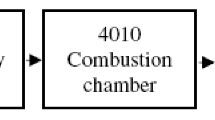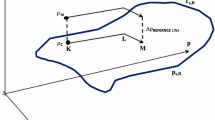Abstract
To create an online diagnostic system for a gas turbine, a well-formulated-influence coefficient matrix (ICM), a key component in a widely used existing theory, is essential. However, according to a recent research of the present authors, parameter deviations estimated by the traditional ICM contain unavoidable errors. These errors, called matching deviations, have been verified to be a consequence of the shifting operating point caused by component deterioration. Here we present a simple and accurate method which is still based on the widely accepted existing theory that accounts for component deterioration. Matching coefficients are introduced in this method to isolate and eliminate matching deviations. The ICM yielded by this method can improve the accuracy of both measurement prediction and parameter deviation estimations. By modeling a commercial power generation engine, a demonstration of the new method is presented and its limitation is discussed.
Similar content being viewed by others
References
L. A. Urban, Parameter selection for multiple fault diagnostics of gas turbine engines, AGARD Conference Proceedings, Liege, Belgium (1974).
L. A. Urban, Gas path analysis of commercial aircraft engines. Proceedings of the 11th Symposium on Aircraft Integrated Data Systems, Cologne, West Germany (1982).
D. L. Doel, TEMPER - a gas-path analysis tool for commercial jet engines, Journal of Engineering for Gas Turbines and Power 116(1) (1994) 82–89.
A. Stamatis, K. Mathioudakis and M. Smith M, Gas turbine component fault identification by means of adaptive performance modeling, Proceedings of ASME Turbo Expo, Brussels, Belgium (1990)90-GT-376.
M. Zedda and R. Singh, Gas-turbine engine and sensor diagnostics, XIV International symposium on air-breathing engines, Florence, Italy. (1999) 255–261.
M. Zedda and R. Singh, Gas turbine engine and sensor fault diagnosis using optimization techniques, Journal of Propulsion and Power 18(5) (2002) 1019–1025.
G. Denny, F-16 Jet Engine Trending and Diagnostics with Neural Networks, Applications of Neural Networks 4 (1965) 419–422.
P. Fuster, A. Ligeza and M. J. Aguilar, Abductive diagnostic procedure based on an AND/OR/NOT graph for expected behaviour: Application to a gas turbine, 10th International Congress and Exhibition on Condition Monitoring and Diagnostic Engineering Management, Helsinki, Finland. (1997).
C. Siu, Q. Shen and R. Milne, TMDOCTOR: A fuzzy rule-and case-based expert system for turbomachinery diagnosis, Proceedings of IFAC Fault Detection, Supervision and Safety for Technical Processes, Kingston Upon Hull, UK. (1997).
Y. G. Li, Performance-analysis-based gas turbine diagnostics: A review, Proceedings of the Institution of Mechanical Engineers, Part A: Journal of Power and Energy 216(5)(2002)363–377.
P. Kamboukos and K. Mathioudakis, Comparison of linear and nonlinear gas turbine performance diagnostics. Journal of Engineering for Gas Turbines and Power 127(1) (2005) 49–56.
M. Naeem, R. Singh and D. Probert, Consequence of areo-engine deteriorations for military aircraft, Applied Energy 70(3) (2001) 103–133.
M. Kurosaki, T. Morioka and K. Ebina, Fault detection and identification in an IM270 gas turbine using measurements for engine control, Journal of Engineering for Gas Turbines and Power 126(4) (2004) 726–732.
D. Xia and Y. H. Wang, Modeling for the calculation of off-design operating conditions of a model PG9171E gas turbine, Journal of Engineering for Thermal Energy and Power, 4(2008) 15–18.
P. Qin, Aerodynamic Design of Axial Flow Compressor, National Defence Industry Press, Beijing, 214–235(1975).
A. R. Howell and R. P. Bonham, Over-all and stage characteristics of axial flow compressors, Proceedings of the Institution of Mechanical Engineers, 163(1950) 235–248.
Y. H. Wang, A new method of predicting the performance of gas turbine engines, Journal of Engineering for Gas Turbines and Power, 113(1991) 106–111.
A. Stamatis, K. Mathioudakis and K. D. Papailiou, Adaptive simulation of gas turbine performance. Journal of Engineering for Gas Turbines and Power, 112 (1990) 168–175.
R. T. Rausch, K. F. Goebel, N. H. Eklund and B. J. Brunell, Integrated in-flight fault detection and accommodation: a Model-based study, Proceedings of ASME Turbo Expo, Reno, Nevada, USA (2005) 05-GT-68300.
H. I. H. Saravanamuttoo, Gas path analysis for pipeline gas turbines. 1st Canadian Symposium on Gas Turbine Operation and Maintenance, USA, (2005).
Z. Ping and S. Hih, Simulation of an advanced twin-spool industrial gas turbine, ASME Journal of Engineering for Gas Turbines and Power, 114 (1992) 180–186.
K. Mathioudakis and A. Tsalavoutas, Uncertainty reduction in gas turbine performance diagnostics by accounting for humidity effects. Proceedings of ASME Turbo Expo, New Orleans, USA (2001) 01-GT-0010.
D. Taylor, Implanted component faults and their effects on gas turbine engine performance, Journal of Engineering for Gas Turbines and Power, 114 (1992) 110–116.
A. Stamatis, K. Mathioudakis, G. Berios and K. Papailiou, Jet engine fault detection with discrete operating points gas path analysis, Journal of Propulsion, 76(1991) 1043–1048.
T. Kobayashi and D. Simon, Hybrid neural-genetic algorithm technique for aircraft engine performance diagnostics, Journal of Propulsion and Power, 21(2005) 751–758.
T. V. Groenstredt, A multipoint gas path analysis tool for gas turbine engines with a moderate level of instrumentation, XV International Symposium on Air-Breathing Engines, Bangalore, India, (2001) 1051–1058.
A. Gulati, D. Taylor and R. Sign, Multiple operating point analysis using genetic algorithm optimization for gas turbine diagnostic, XV International Symposium on Air-Breathing Engines, Bangalore, India, (2001) 1–8.
Author information
Authors and Affiliations
Corresponding author
Additional information
This paper was recommended for publication in revised form by Associate Editor Tpmg Seop Kim
Di Xia received a B.S. degree in Mechanical Engineering from Tongji University and is currently a Ph.D. candidator at the School of Mechanical Engineering at Jiaotong University in Shanghai, China. Dr. Xia’s research interests are in the area of gas turbine and gas path analysis.
Rights and permissions
About this article
Cite this article
Xia, D., Wang, Y. & Weng, S. A new method to evaluate the influence coefficient matrix for gas path analysis. J Mech Sci Technol 23, 667–676 (2009). https://doi.org/10.1007/s12206-008-1117-y
Received:
Revised:
Accepted:
Published:
Issue Date:
DOI: https://doi.org/10.1007/s12206-008-1117-y




